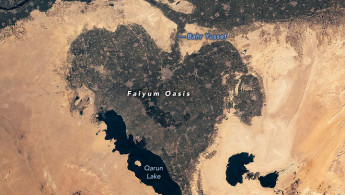NASA releases images of 'heart-shaped' oasis spotted in Egypt on Valentine's Day
Satellite imagery of a heart-shaped oasis located in the Egyptian desert was released as "Photo of the Day" on Monday by the NASA's Earth Observatory to mark Valentine's Day 2022.
The heart-shaped feature was first spotted in May 2021 from space. On Earth, the spot is known as Faiyum Oasis, a 1,200 square kilometres wetland filled with water, vegetation and rare fossils.
Located southwest of Cairo, the oasis is thought to have sustained life for over 8,000 years. It's main water body, Lake Qarun (also known as Lake Moeris), was historically fed by water overflowing seasonally from the nearby Nile river.
Egyptian pharaohs encouraged this phenomenon through ambitious engineering projects to expand the waterways between the river and Faiyum, but this did not prevent the lake from eventually shrinking significantly.
The lake and immediate surroundings are a protected area since the nineties, and the site was recognised as a Ramsar site - a wetland of international importance - since 2012.
Despite these protection measures, this unique environmental jewel is under stress.
The Egyptian government has long promised to take action to address environmental threats to the oasis, including pollution, increasing water salinity and the flow of sewage water and agricultural wastewater into Lake Qarun.
At the end of January, Egypt announced it had "spent billions" on cleaning polluted lakes where declining fish numbers have severely impacted fish farming.
The declaration followed the publication of a study by the Egyptian Journal of Aquatic Life and Fisheries, which said Egypt's fish production had fallen sharply due to pollution, overfishing and habitat degradation.
Among the affected waterways was Lake Qarun, where local fishermen recently warned that the water for fish to survive.





 Follow the Middle East's top stories in English at The New Arab on Google News
Follow the Middle East's top stories in English at The New Arab on Google News
![The UAE is widely suspected of arming the RSF militia [Getty]](/sites/default/files/styles/image_330x185/public/2024-11/GettyImages-472529908.jpg?h=69f2b9d0&itok=Yauw3YTG)
![Netanyahu furiously denounced the ICC [Getty]](/sites/default/files/styles/image_330x185/public/2024-11/GettyImages-2169352575.jpg?h=199d8c1f&itok=-vRiruf5)
![Both Hamas and the Palestinian Authority welcomed the ICC arrest warrants [Getty]](/sites/default/files/styles/image_330x185/public/2024-11/GettyImages-2178351173.jpg?h=199d8c1f&itok=TV858iVg)